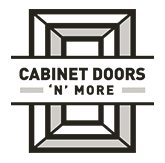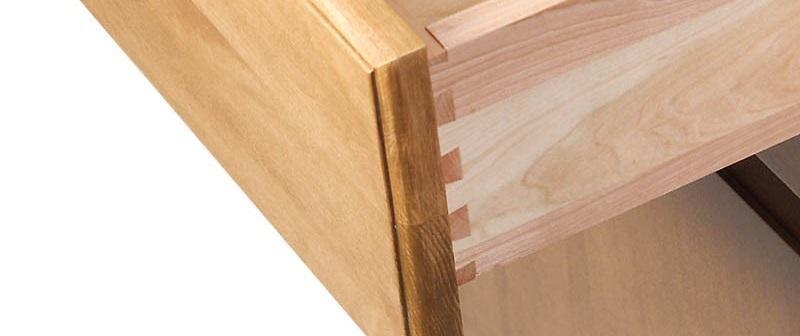
A common technique for woodworking and carpentry that craftsmen have long relied on is dovetail joints. Dovetail joints, also called swallowtail joints in England, date back to ancient Egypt, when Egyptians used this technique for coffins. Throughout most of history, dovetail joints have proven to be a durable technique used to hold together various woodworking projects before modern innovations. Even today, these joints remain one of the sturdiest choices when constructing corners.
Looking for dovetail joints in wooden items is a quick and easy way to check for a long-lasting piece with a quality build. A simple but effective woodworking technique, dovetail joints ensure strength and longevity. So, before purchasing an item crafted from wood, it is important to know how to look for various types of dovetail joints to ensure you get the best quality work for your money.
The Background and Features of Dovetail Joints
Dovetail joints, one of the strongest joints in carpentry, are woodworking seams that connect two pieces of wood by fitting them in with one another, similar to connecting two puzzle pieces. The end of one piece of wood is complementary to the other, creating an interlocking corner. The way the two pieces fit together makes it difficult to pull the corner apart. Applying adhesive to the joint gives it extra protection and prevents any separation between the pieces at all.
This joint type has two parts, called pins and tails. You can tell the difference between these two pieces because the tails are flared triangular shapes, while the pins are thinner.
The tails, which look like those of a dove, are what give the dovetail joint its name. They make up the edge of one board, and the pins are on the other wooden piece. The pins and tails fit together in a way that interlocks naturally and effectively, preventing separation.

A variety of wooden furniture and many other wood crafts utilize the dovetail joint, such as chests, cabinets, drawers, cupboards, jewelry boxes, tables, partitions, frames and even wooden instruments. Because of their stability and aesthetic aspects, dovetail joints are a popular joint option for skilled wood crafters. Dovetail joints have evolved over time, and woodworkers have adapted this joining method to best suit their craft’s design based on the function and aesthetic they want to achieve.
Types of Dovetail Joints
There are five variations of dovetail joints, all put together with slightly different methods. Some of these approaches are more complex than others, but they all use the same basic design to create a dovetail effect that allows for secure and sturdy wood crafts. Crafters use different variations of this joint for various reasons. The factors determining which joint will be most effective include what dovetail joint best supports the craft and which angles of the dovetail the designer wants to have visible.
There are five dovetail joint types to pick from:
Through Dovetail
The through dovetail joint, alternately called the plain dovetail, is the most basic of its kind. This type of dovetail uses a method that resembles interlocking fingers. Crafters achieve this look by joining join two pieces of wood together by interlocking the pins and the tails. Through dovetail joints have consistent angles with no gaps between the pins and tails. This method allows you to see the end-grain of both wooden pieces, the pin side and the tail side from all outside surfaces.
Traditionally, woodworkers covered through dovetail joints with veneers to mask where the two pieces interlocked. However, people began to embrace the unique style of seeing the end-grain and the way the two pieces interlock in a beautiful way. As a result, contemporary work shows the through dovetail joint as a notable feature that signifies skilled craftwork and artistry.
Half-Blind Dovetail
The half-blind dovetail, also known as the single-lap dovetail, differs from the through dovetail because you can only see the end-grain from one side instead of both. Craftworkers use this joint if they do not want the end-grain visible from the front of the piece. This method requires the wood crafter to stop cutting the pins before getting the entire way through the wood, creating a shield so that viewers cannot see where the tails fit into the pins.
This technique acts as an alternative to adding false fronts to hide where the two pieces of wood intersect. If you do not want to see the end-grain of wood pieces on your furniture, cabinet or drawer, but you also do not want to add extra material to have a false front, the half-blind dovetail joint may be a design option for you to consider.
Secret Mitered Dovetail
This type of dovetail joint, also referred to as the full-blind dovetail, is a joint type designed to hide the dovetail’s outward appearance. One of the more complex dovetail joints, woodworkers use the secret mitered dovetail to prevent you from seeing the wood’s end-grain from any angle. The only way to have a successful secret mitered dovetail is to use two wooden pieces of equal thickness.
Creating this joint involves the craftworker refraining from cutting the pins and tails all the way through, hiding the joint from both the inside and outside corners instead. Woodworkers accomplish this feat by connecting the pins and tails internally with the edges of the wooden pieces meeting at a 45-degree angle to form a 90-degree angle with no visible end-grain.

Secret Double-Lapped Dovetail
Secret double-lapped dovetails are a similar variation to the secret mitered dovetail. The only difference between these methods is that the secret double-lapped dovetail joint has a thin section of end-grain on one wooden piece that forms the end of the joint. This construction means that these dovetails connect without the use of a miter joint, or a joint formed at an angle.
This type of dovetail joint is most commonly used to construct boxes and can also be found in the structural framework of buildings and pieces of furniture.
Sliding Dovetail
Sliding dovetail joints function by joining two boards at a right angle, with the side of one wooden board cut into a tail. The other wooden board needs to have a socket cut into it away from the edge of the board. The two pieces interlock when you slide the tail into the socket. Woodworkers can taper these sockets, too. When they taper the pieces, they gradually narrow the thickness of the socket toward one end of the interlocking mechanism.
Applying this method toward the end of the board allows woodworkers to make the connection of the two boards tighter and more secure. This type of dovetail joint is often used to join cabinet bottoms to the sides and cabinet sides to cabinet shelves. A unique application of a sliding dovetail joint can be found in some violins and guitars. This dovetail joint can be used to join the neck to the body of these instruments.
Benefits of Dovetail Joints
Dovetail joints have many beneficial qualities that make furniture and other items made with this technique stand apart. The qualities of a dovetail joint are desirable because they're signs of quality craftsmanship. Some advantages of dovetail joints that make them a more attractive option than others include their:
Strength
Woodcrafts of high quality often rely on the dovetail joint to ensure durability, as this joint is one of the strongest connection methods. Dovetail joints are naturally durable by design because of the precise cuts of the pins and tails, which allow these joints to remain sturdy without requiring reinforcement.
Dovetail joints are strong enough to last over the years. Many wooden pieces of furniture or cabinetry in an antique shop will exhibit constructions with dovetail joints. Despite their age, this furniture will most likely still be in excellent condition and able to be used.
Ability to Interlock
The main reason dovetail joints are so advantageous is because of their ability to interlock the two pieces of wood so strongly. This capability gives the wood piece a natural yet beautiful look that does not require additional sections, saving building materials and creating less waste. The interlocked pieces make dovetail joints ideal for high-stress applications.
For example, the fronts of drawers undergo significant amounts of stress. While it may not be something you normally think about, the front of a drawer faces stress during normal use as it gets pulled to open the drawer and then is slammed shut against the frame. Dovetail joints ensure the drawer stays in one piece over many years of consistent use.

Lack of Mechanical Fastener
Two wooden pieces connected with a dovetail joint fit together in a way that is known for its resilience and ability to hold the wood together with no mechanical fasteners. Because this technique does not involve any visible fastener, such as nails, screws or bolts, it makes this technique a more attractive option for wood furniture.
Large Gluing Area
Some woodworkers give dovetail joints extra support that prevents separation over time by using an adhesive. Because of the width of the tails and pins, this joint leaves a relatively large spot to apply adhesive, meaning that the glue has a greater area to attach to. The way the pieces interlock means you cannot see the glue, and it is more likely to hold.
Attractive Design
Another major reason that dovetail joints are so popular is their beauty. You can rarely find dovetail joints in mass-produced wood pieces, as this joint method is handmade. The ornamental design of hand-cut dovetail joints makes wooden pieces have a unique look while still being functional and sturdy.
Dovetail joints are also a sign of authentic wooden pieces that are made of quality lumber materials. When trying to differentiate between a quality piece of wooden furniture and something that has been mass-produced with cheaper materials, look for dovetail joints.
Ability to Withstand Contraction and Expansion
Wood can expand and contract in conditions like heat and moisture, especially in large wood projects. Dovetail joints are commonly used for large projects because they can withstand contraction and expansion. If a wood piece is properly constructed with dovetail joints, its structural integrity will remain uncompromised as it changes in size.
Dovetail Joints in Drawer Boxes
Dovetail joints, because of their strength and durability, are helpful for high-use furniture. For example, if you are looking to redo or renovate your kitchen or bathroom, a simple place to start is by checking your drawer boxes. Looking at their craftsmanship allows you to see if they have a dovetail joint, which will ensure the strength and longevity of your drawers. If you see any other type of joint or connector, consider upgrading your drawer boxes.
Drawer boxes come in various materials. Manufacturers mostly make drawer boxes from particle board or chipboard, which is a wood product made from wood chips and synthetic resin. Drawer boards also come in either a 3-sided or 4-sided design. Designs with three sides have a drawer front that is the front wall of the drawer box. Four-sided draw boxes are more like an insert that you then mount a drawer front onto. Boxes with four sides are more durable, hold more weight and last longer than 3-sided drawers.
To see if you have cabinet drawers with dovetail joints, simply open any drawer box in your kitchen or bathroom and look at the side near the drawer glides. If you see a solid wood, "dovetailed" wooden bow-like shape on all four of the sides that support the drawer fronts, then this means your drawer will most likely last for many years to come.
If you do not see this shape, consider upgrading your drawers so that you can experience a higher quality and more stable kitchen cabinet with a four-sided dovetail joint drawer box. Since you constantly open and close drawers, investing in a drawer box with more longevity and strength will be beneficial.
About Cabinet Doors ‘N’ More

At Cabinet Doors ‘N’ More, we take pride in helping contractors and homeowners remodel cabinets and drawers for kitchens, bathrooms and storage areas. With over 30 years of industry experience, we are a leader in online kitchen and bathroom cabinetry, providing a variety of customized cabinet components to help you complete your remodeling projects quickly and easily.
If you’re looking to reface your existing cabinetry with stylish and cost-effective products, look no further than Cabinet Doors ‘N’ More. We produce a full line of refacing products to assist with any remodeling you are looking to complete. We offer great prices on cabinet doors, drawer fronts, drawer boxes and cabinet accessories.
Contact Us Today!
Partnering with Cabinet Doors ‘N’ More for any of your DIY cabinet projects is an easy decision you won’t regret. Order as little as one cabinet component for a quick repair or order multiple cabinet doors for a large-scale renovation. Whatever you choose, you will enjoy free shipping on all orders, fast delivery and exceptional customer service. Check out our selection of products online!
You can learn more about our products by contacting Cabinet Doors ‘N’ More today, or start your ordering process now. Call us at 1-667-877-8777 or email us at info@cabinetdoorsnmore.com for more information.
LEARN MORE ABOUT DRAWER BOXES








